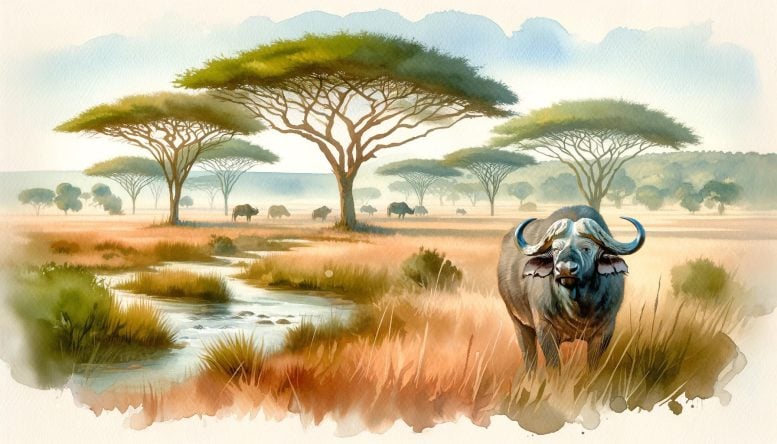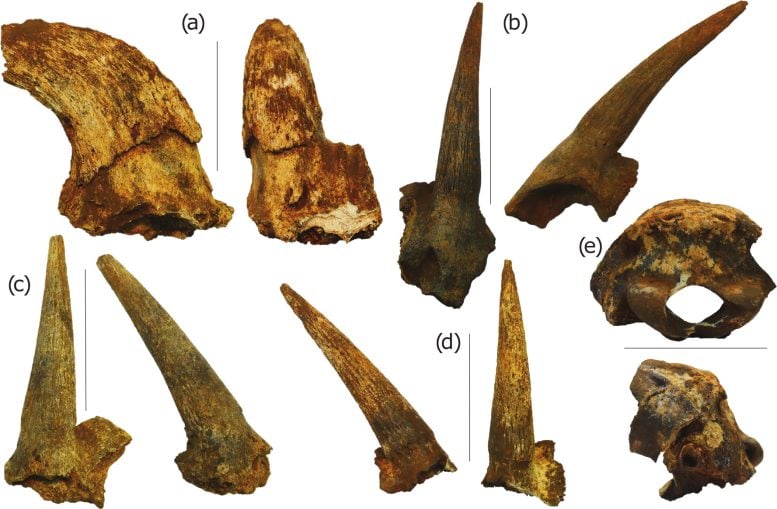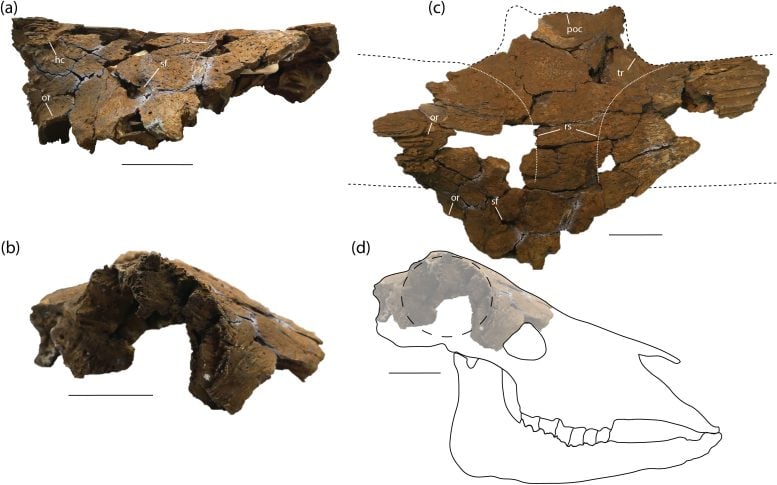

An African buffalo within the savanna. Credit score: GENUS: DSI-NRF Centre of Excellence in Palaeosciences
New fossil discoveries at South Africa’s Kromdraai website provide groundbreaking insights into the traditional ecosystems and their position in shaping human evolution, highlighting the interaction between hominins and varied bovid species.
Within the sprawling savannas of South Africa’s Cradle of Humankind, the Kromdraai archaeological website has unveiled a brand new discovery that considerably enhances our understanding of the ecosystems that influenced human evolution.
Researchers have unearthed a group of fossilized bovids, revealing the presence of beforehand unknown species that when roamed these historic grasslands alongside our hominin ancestors. This vital discovering, detailed in a research revealed in Quaternary Science Opinions, not solely highlights the biodiversity of the Plio-Pleistocene period but in addition presents unprecedented insights into the environmental circumstances that influenced the event of early human species.
Among the many notable discoveries is an unknown medium-sized buffalo species, underscoring the complexity of historic ecosystems and the pivotal position these environments performed in shaping the evolutionary pathways of hominins like Paranthropus robustus and early Homo species. “Paleontology usually conjures photographs of dinosaurs, however learning trendy animals like bovids is essential too. Bovids are numerous and profitable in Africa, providing insights into each historic and trendy ecosystems. Their evolutionary historical past is intertwined with ours, as they’ve been a key a part of the panorama and human societies because the Miocene, about 23 million years in the past,” Dr Raphael Hanon, lead writer and a Postdoctoral Researcher on the Evolutionary Research Institute, College of Witwatersrand, notes.
Insights from the Plio-Pleistocene Period
Spearheaded by a collaborative staff of researchers from across the globe, this revelation paints a vivid image of a panorama dominated by expansive grasslands, hinting on the complicated interaction of life that thrived on this area through the Plio-Pleistocene period (about 5.3 million years in the past). This analysis marks a major leap ahead in our quest to unravel the mysteries of our planet’s previous, offering essential information for reconstructing the traditional landscapes that have been the cradle of humankind. “It isn’t quite common in bovid paleontology to come back throughout a mysterious well-preserved cranium. Even when the specimen isn’t full, the invention and outline of a possible new species of small-sized buffalo is absolutely attention-grabbing!” Raphael explains.

Antidorcas from Kromdraai Unit P: (a) Proper horn-core of a male (A. recki) proven in aspect and entrance views (KW 9995). (b) Left horn-core in entrance and aspect views (KW 11161). (c) Proper horn-core in entrance and aspect views (KW 10704). (d) Proper horn-core in aspect and entrance views (KW 9611). (e) Partial again of the cranium (occipital bone) (KW 10410). Scale = 5 cm. Credit score: GENUS: DSI-NRF Centre of Excellence in Palaeosciences. {Photograph} offered by Dr Rapahel Hanon
These bovids, family members Bovidae, which incorporates modern-day buffalo, antelopes, and gazelles, function a key to unlocking the secrets and techniques of the previous. Their range and abundance at Kromdraai provide a glimpse into the diets and behaviors of each giant carnivores and our historic family. As prey, these animals formed the predatory patterns of the area’s megafauna and, by extension, influenced the survival methods of hominins akin to Paranthropus robustus and early Homo species.
Habitat Preferences and Bovid Range
The invention of extinct species of gazelles akin to Gazella gracilior and the presence of a yet-to-be-named buffalo carefully associated to Syncerus acoelotus point out a grassland-dominated setting. This discovering is corroborated by comparisons with different Plio-Pleistocene websites throughout South Africa, which counsel that completely different hominin species have been related to various habitats.
Whereas Australopithecus appeared to favor woodland and closed-wet environments, early Homo species have been present in areas tailored to open and dry circumstances. The various vary of bovids related to Paranthropus, nevertheless, suggests a broad environmental adaptability amongst these hominins. Raphael explains that this analysis was considerably difficult. “One of many largest challenges was to reconstruct and describe the small buffalo cranium (Syncerus sp.) to determine it,” he says.
“The cranium was found as dozens of small damaged bone items and Jean-Baptiste Fourvel and myself spent hours on it to have the ability to refit many of the items collectively so we’d be capable to inform what sort of animal it was. Even after refitting all of the items, it was very fragile – subsequently tough to control and determine. The fossil file of the African buffalo is scarce, particularly in South Africa, so it was not simple to search out related info that would assist us determine the cranium,” he explains.

Small Buffalo Syncerus sp. Cranium from Kromdraai Unit P: (a) Entrance view, (b) Aspect view, (c) High view of the frontlet KW 9463. (d) Reconstructed right-side view of the cranium. Scale = 5 cm. Credit score: GENUS: DSI-NRF Centre of Excellence in Palaeosciences. {Photograph} by Dr Raphael Hanon
The importance of those findings extends past the mere identification of historic animals. The bovid assemblages of Kromdraai, with their mixture of older Plio-Pleistocene and youthful Pleistocene taxa, provide a window into the altering landscapes of historic Africa. These adjustments, recorded within the bones and enamel of the bovids, replicate the dynamic nature of our planet’s ecosystems and the adaptability of life within the face of shifting climates and habitats.
Furthermore, the research of those fossils supplies a chronological marker for the location, with the biochronology indicating that Kromdraai Unit P collected between 2.9 and 1.8 million years in the past. This vary is essential for understanding the timeline of human evolution within the area, providing potential insights into the looks of Paranthropus robustus and different vital species in southern Africa.
The Kromdraai website continues to be a testomony to the richness of our planet’s previous, inviting scientists and fans alike to ponder the intricate connections between the earth’s historical past and our origins. Raphael is worked up to increase his scientific analysis additional. “I’ll proceed to work on bovid paleontology and taxonomy sooner or later. I hope to have the ability to conduct a extra detailed evaluation of particular taxa such because the buffalos or the gazelles in South Africa. Loads of palaeontological and archaeological websites have yielded an enormous quantity of bovid fossil materials that’s simply ready to be studied,” he says.
Reference: “New fossil Bovidae (Mammalia: Artiodactyla) from Kromdraai Unit P, South Africa and their implication for biochronology and hominin palaeoecology” by Raphaël Hanon, Jean-Baptiste Fourvel, Recognise Sambo, Nompumelelo Maringa, Christine Steininger, Bernhard Zipfel and José Braga, 26 March 2024, Quaternary Science Opinions.
DOI: 10.1016/j.quascirev.2024.108621
The research was funded by the Genus-DSI-NRF Centre of Excellence in Palaeosciences.

